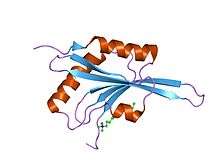ADF-H domain
| Cofilin_ADF | |||||||||
|---|---|---|---|---|---|---|---|---|---|
 crystal structure of adf1 from arabidopsis thaliana | |||||||||
| Identifiers | |||||||||
| Symbol | Cofilin_ADF | ||||||||
| Pfam | PF00241 | ||||||||
| Pfam clan | CL0092 | ||||||||
| InterPro | IPR002108 | ||||||||
| SMART | ADF | ||||||||
| PROSITE | PDOC00297 | ||||||||
| SCOP | 2prf | ||||||||
| SUPERFAMILY | 2prf | ||||||||
| CDD | cd00013 | ||||||||
| |||||||||
In molecular biology, ADF-H domain (actin-depolymerising factor homology domain) is an approximately 150 amino acid motif that is present in three phylogenetically distinct classes of eukaryotic actin-binding proteins.[1][2][3]
- ADF/cofilins, which include ADF, cofilin, destrin, actophorin, coactosin, depactin and glia maturation factors (GMFs) beta and gamma. ADF/cofilins are small actin-binding proteins composed of a single ADF-H domain. They bind both actin-monomers and filaments and promote rapid filament turnover in cells by depolymerising/fragmenting actin filaments. ADF/cofilins bind ADP-actin with higher affinity than ATP-actin and inhibit the spontaneous nucleotide exchange on actin monomers
- Twinfilins, which are actin monomer-binding proteins that are composed of two ADF-H domains
- Abp1/Drebrins, which are relatively large proteins composed of an N-terminal ADF-H domain followed by a variable region and a C-terminal SH3 domain. Abp1/Drebrins interact only with actin filaments and do not promote filament depolymerisation or fragmentation. Although these proteins are biochemically distinct and play different roles in actin dynamics, they all appear to use the ADF-H domain for their interactions with actin.
The ADF-H domain consists of a six-stranded mixed beta-sheet in which the four central strands (beta2-beta5) are anti-parallel and the two edge strands (beta1 and beta6) run parallel with the neighbouring strands. The sheet is surrounded by two alpha-helices on each side .[1][2][4]
References
- 1 2 Lappalainen P, Kessels MM, Cope MJ, Drubin DG (August 1998). "The ADF homology (ADF-H) domain: a highly exploited actin-binding module". Mol. Biol. Cell. 9 (8): 1951–9. doi:10.1091/mbc.9.8.1951. PMC 25446
 . PMID 9693358.
. PMID 9693358. - 1 2 Paavilainen VO, Merckel MC, Falck S, Ojala PJ, Pohl E, Wilmanns M, Lappalainen P (November 2002). "Structural conservation between the actin monomer-binding sites of twinfilin and actin-depolymerizing factor (ADF)/cofilin". J. Biol. Chem. 277 (45): 43089–95. doi:10.1074/jbc.M208225200. PMID 12207032.
- ↑ Liu LX, Xu H, Weller PF, Shi A, Debnath I (February 1997). "Structure and expression of a novel filarial gene for glia maturation factor". Gene. 186 (1): 1–5. doi:10.1016/S0378-1119(96)00585-9. PMID 9047337.
- ↑ Liu L, Wei Z, Wang Y, Wan M, Cheng Z, Gong W (November 2004). "Crystal structure of human coactosin-like protein". J. Mol. Biol. 344 (2): 317–23. doi:10.1016/j.jmb.2004.09.036. PMID 15522287.
This article incorporates text from the public domain Pfam and InterPro IPR002108
This article is issued from Wikipedia - version of the 5/20/2016. The text is available under the Creative Commons Attribution/Share Alike but additional terms may apply for the media files.